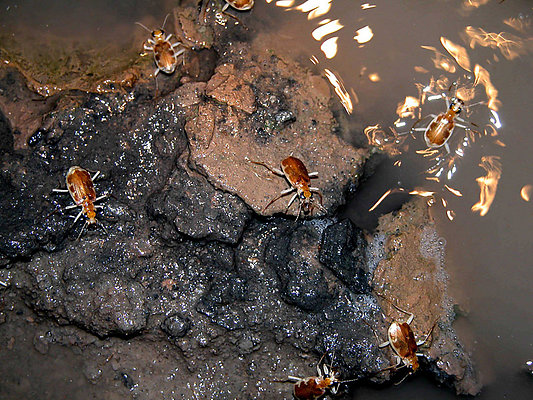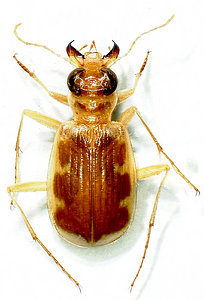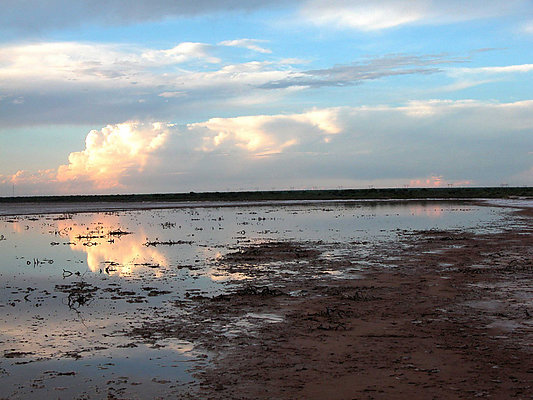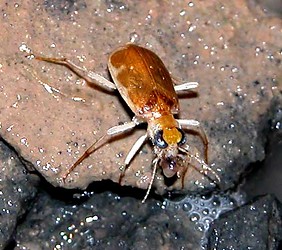Cicindis horni
Hornís Fairy Shrimp Hunting Beetle
Terry ErwinHabitat
MACROHABITAT: Margins of large salt flats near vernal pools. MICROHABITAT: Adults occur on wet to inundated clay mixed with salt where polygons form when the clay dries out and with no vegetation cover.
Seasonality
Adults are found in December-March; copulating pairs observed in March; teneral adults in February.
Behavior
This heretofore very rare species was recently found to be markedly unusual among carabid beetles because adults surface-swim and dive in search of their prey, an anostracan fairy shrimp, possibly a species of Thamnocephalus Cohen. Adult beetles do not run along the shore at the margin of the ponds that are formed in the great salt flats like most carabid in this type of habitat elsewhere. However, they do rest in small burrows during the day away from the water's edge, and emerge before nightfall (crepuscular behavior). They then spend the night in search of food or mates swimming on the water surface of markedly alkaline water bodies (17% salinity).
Tibial natatorial setae, tarsal setal fringes, ventral vestiture, and genal/pronotal planing surfaces plus decumbent and very sharply pointed mandibles are specific adaptations that permit this species to behave as a swimming superspecialist predator. Subsequent studies have shown that adults also run on very wet and sticky mud at the edge of vernal pools in search of mates.


Specimens of Cicindis horni at night in their habitat at Salinas Grandes, Argentina.
Mating can take place on the water surface, or on adjacent mud. Adults are best collected by net at night over the pool, by hand when they are running on the mud adjacent to the pool, or at UV and Mercury Vapor lights; and they sometimes can be obtained in pitfall traps placed very near the water's edge. Immature stages and hibernation site unknown.
Dispersal Potential
Adults are fully winged and fly readily at night; adults also are swimmers and divers in vernal pools with 17% salinity.
References
Bruch, C. (1908) Eine neue Carabidendengattung aus Argentinien. Cicindis horni (Col.). Deutsche Entomologische Zeitschrift, 1908, 497-500.
Erwin T.L. & Aschero, V. (2004b) Cicindis horni Bruch (Coleoptera: Carabidae, Cicindini): The Fairy Shrimp Hunting Beetle, its way of life on the Salinas Grandes of Argentina. Zootaxa, 553, 1-16.
Kavanaugh, D.H. & Erwin, T.L. (1991) The tribe Cicindini Bšnninger (Coleoptera: Carabidae): Comparative morphology, natural history, and reclassification. Proceeding of the Entomological Society of Washington, 93(2), 356-389.
About This Page
Terry Erwin

National Museum of Natural History, Smithsonian Institution, Washingtion, D. C., USA
Correspondence regarding this page should be directed to Terry Erwin at
Page copyright © 2006 Terry Erwin
 Page: Tree of Life
Cicindis horni . Hornís Fairy Shrimp Hunting Beetle.
Authored by
Terry Erwin.
The TEXT of this page is licensed under the
Creative Commons Attribution-NonCommercial License - Version 3.0. Note that images and other media
featured on this page are each governed by their own license, and they may or may not be available
for reuse. Click on an image or a media link to access the media data window, which provides the
relevant licensing information. For the general terms and conditions of ToL material reuse and
redistribution, please see the Tree of Life Copyright
Policies.
Page: Tree of Life
Cicindis horni . Hornís Fairy Shrimp Hunting Beetle.
Authored by
Terry Erwin.
The TEXT of this page is licensed under the
Creative Commons Attribution-NonCommercial License - Version 3.0. Note that images and other media
featured on this page are each governed by their own license, and they may or may not be available
for reuse. Click on an image or a media link to access the media data window, which provides the
relevant licensing information. For the general terms and conditions of ToL material reuse and
redistribution, please see the Tree of Life Copyright
Policies.
- First online 19 June 2006
- Content changed 21 June 2006
Citing this page:
Erwin, Terry. 2006. Cicindis horni . Hornís Fairy Shrimp Hunting Beetle. Version 21 June 2006. http://tolweb.org/Cicindis_horni/911/2006.06.21 in The Tree of Life Web Project, http://tolweb.org/











 Go to quick links
Go to quick search
Go to navigation for this section of the ToL site
Go to detailed links for the ToL site
Go to quick links
Go to quick search
Go to navigation for this section of the ToL site
Go to detailed links for the ToL site